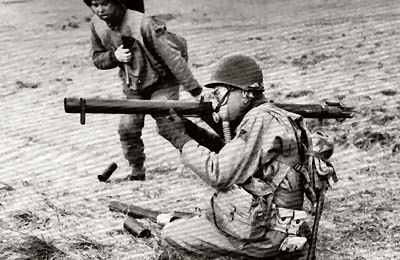As against the heavier German tanks, the 2.36 in bazooka was not sufficiently effective against the rugged T34, arguably the best tank developed in WWII. The 2.36 could penetrate the T-34 armor, but only marginally, and could be defeated by the sloping, heavy armor surfaces. Unless firing from a flanking ambush, or catching the T-34 rounding a corner, the infantryman was faced with the 3.5in sloping frontal armor, and an 85mm gun. Actually, the 2.36 should never have been deployed in Korea, as the M9A1 and other 2.36 inch models had been withdrawn from service shortly after WWII, and nominally replaced with the M20, of similar design but with a larger rocket. The M20 was deadly against the T34.
To escape backblast, the operator held the bazooka on his shoulder with about half the tube protruding behind him. The chief defects of both bazookas were their unwieldy weight and length, their short effective range, and their cumbersome two-man operating team. Beginning with Vietnam the Army switched to light antitank weapons, or LAWs, such as the M72, a one-shot, disposable weapon that weighed 5 pounds fully loaded yet could launch its rocket with reasonable accuracy out to 350 yards.
Both the 2.36 inch and the 3.5 inch bazookas were deadly effective against dug-in troops, as a short-range anti-pillbox and anti-personnel weapon. They were also effective against mobile machine gun and mortar crews who moved forward with the second assault, or submachine gun, platoons, to support them at close range.



